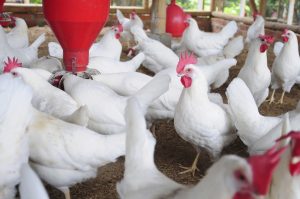While all the sound and fury has been coming from the human-centric lobby, there’s been a quiet revolution going on in the agricultural sector. LED technology has brought massive change to the lighting for horticulture sector and the rearing of livestock. By creating LED systems that offer special spectral outputs, crop and livestock production is enhanced, reducing costs and increasing profits for farmers, while at the same time improving the quality of the product.
Historically, lighting in agriculture was seen purely from a human standpoint. It may be that our light sources left us with little option than to make the best use, or what we perceived as best use, of those sources. Now that we have a ‘tunable’ light source we are able to focus on providing the plants, birds and beasts with the best growing environment.
Horticultural lighting
Research has identified specific wavelengths that are needed to promote growth and fruiting in plants. By applying LED technology it has been possible to create dedicated lighting systems.
For example: chlorophyll absorption occurs in two ranges, 400-500nm and 600-700nm, and that means plants grow most efficiently under blue and red light. It’s worth noting here that plants are seen to be green because they reflect that wavelength. Green light is of no use to the plant at all.
The amount of light required for photosynthesis to take place matters because there is a direct relationship between the two, up to a point. There is a light saturation point where the plant cannot absorb any more chlorophyll, at around 700 micromoles per m2 per second. Any further illumination is a waste of energy (and money).
EXPLAINER: Micromoles
Lighting for plants is measured in micro-moles per second. Micromoles measure the number of photons that pass through a target area; one micromole of light equals a little over 62 quadrillion photons. That sounds very complicated but a new range of spectrometers is now available that provides micromoles per m2 per second readings as simply as they do readings in Lux.
Artificial lighting has been used historically to help extend the ‘growing day’ but we are seeing a move towards total managed environments where artificial lighting provides 100 percent of the illumination in the growing sheds. The LED systems are tuned to provide specific wavelengths according to the growth cycle of the specific plants.
Blue light can stimulate flowers to open up, beginning the plant’s daytime circadian cycle
Red light (and enhanced red light) is good for stem growth and flowering
Infra-red light can mimic the effect of sunset
The ratio between blue and red LEDs is specific to the plant type.
Poultry shed lighting
Getting the light right for poultry breeding is essential, because getting it wrong can be catastrophic for the population of a poultry shed. Stressed fowl become aggressive and it has been known for entire flocks of chickens and turkeys to be destroyed overnight as a consequence of the violence wreaked by the birds.
Research has identified the wavelengths that domestic fowl best respond to and it has been possible to create lighting that mimics the forest under-canopy lighting that birds ‘remember’ in their genetic make-up. This means that domestic fowl have peak sensitivity in the blue-green range, from around 500nm – 700nm, but there is also a substantial response in the UV(A) range – chickens can see ultra violet light that is invisible to humans.
Light at the red end of the spectrum needs to be handled very carefully. Red light promotes sexual activity and growth rate, though it is also thought that the excitation caused by the red wavelength can also be the cause of aggressive behaviour in well-populated sheds.
For the producer, the ideal situation is to create an environment where poultry do not exhibit stressful behaviour, such as over-eating. Layers also need to produce eggs with consistent sizes and ample shell thickness and fowl grown for their meat need sufficient environmental stimulation so that they move around, helping muscle development.
An LED system using specific wavelengths during the course of the day can result in an ideal outcome for the producer. It will produce calm birds that eat less but convert more of that food into body mass, they also come to maturity more quickly in a stress-free state, which means better meat for the customer.
Pig and beef unit lighting
Generally speaking, a lot of research still needs to be done on lighting for pigs and cattle. As we get closer to the human condition, the effect of 100 percent artificial lighting environments suggest that the situation is complicated.
Some of the data is to be expected:
24-hour illumination of pig sheds has reported detrimental effects
24-hour darkness is not an optimal condition
Piglets and weanlings benefit from additional daylight hours, but reproductive behaviour in boars is enhanced by reduced daylight hours. It all sounds very human.
From the point of view of the unit manager, one piece of information is valuable; neither pigs nor cattle appear to have any response to red light. This means that units can be supervised during the night-time by using red lighting – sufficient for security and over-seeing without upsetting the desired circadian rhythms of the beasts themselves.
As research data becomes available, it will be possible to design a lighting regime for pig units and cattle units that is cost-effective for the producer and most beneficial for the beasts themselves.
In summary, as the world’s demand for food increases, producers will need to find the most efficient ways of raising crops and livestock. For those products to have any real nutritional value for the (literal) consumer, then it is beholden on those producers to make sure that growing conditions are optimised for each species. LED lighting is well-placed to deliver the appropriate illumination.
agricultural lighting · horticultural lighting · led agriculture · led lighting · Novel Energy Lighting · poultry lighting · tunable light


